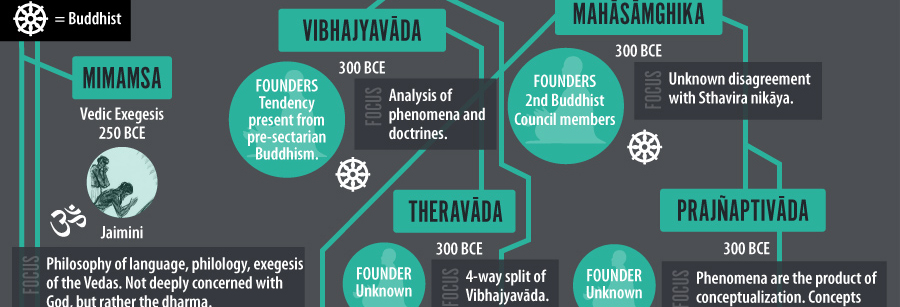
Enormous Chart of Eastern Philosophy
The folks at Super Scholar, who were responsible for a chart of the history of Western philosophy (previously), have now produced a chart of the history of Eastern philosophy. Comments and suggestions are welcome.

Source: SuperScholar.org


Apparently, the folks are not versed in East Asian philosophy… What does it mean by “水=Confucianism”?? “水 (i.e. water)” is by no means an important concept (not even a peripherally relevant concept) in Confucianism! And “school of naturalists”? And skipping more than two thousand years, jumping directly from Confucian to Mao (what? Mao is a philosopher??)? And no mention of Japanese (exception “Shinto” in its early form) and Korean philosophies? …
First, this chart would be better served not treating “Eastern philosophy” as a single discrete category. That would allow more space for properly treating the vast histories of philosophy in India, China, Japan, Korea, and so on.
Second, in terms of its treatment of Indian philosophy, I am puzzled by the omission of the Grammarian tradition (Pāṇini, Patañjali, Bhartṛhari…) as well as the Nyāya, who are only represented as “Vaisheshika” in two terminal nodes, oddly characterized only as a “logical system to prove the Veda” (their concerns were much more wide-ranging). Similarly, Mīmāṃsā (note diacritical marks missing in the chart) is given only a single terminal node with Jaimini in 250 BCE, as if he is the last word and not the beginning! These three–Grammar, Nyāya, and Mīmāṃsā–are central to the “āstika” (so-called “orthodox”) tradition of Indian philosophy, and ought to be given more representation. One would be forgiven, reading the history of Indian philosophy in this chart, for thinking that the history of Indian philosophy is primarily Buddhism, which it is not.
With just these problems noted–and there are more, but I think the point is clear–as well as the spelling errors throughout (“Patanjali” instead of “Patañjali”, “Vedanta” instead of “Vedānta”), I think they ought to go back to the drawing board.
This may be the worst chart of East Asian philosophy ever. Super Scholar is neither.
Um, Socrates was a sixth century BC thinker?
I am still puzzled by how they got the idea of “水 (water) =Confucianism”. My guess is that they wanted to say “仁(benevolence, humaneness) = Confucianism” but they didn’t read Chinese and confused “水” with “仁”…
I thought someone else might bring it up, but I’m not sure why the Islamic tradition is Eastern. At least in Religious Studies, Islam is treated as part of the West. Also, there is a heavy dose of Aristotelian and Platonic influence, isn’t there? Not rhetorical questions — just wondering out loud.
I limited my comments to Indian philosophy, since that’s my area of research, but I agree. I think the chart is really more a catch-all of “not Western” philosophy. Islamic philosophy thrived in parts of what we now know as Europe as well as Africa. I wouldn’t want to characterize either of those as “Eastern.”
Also, to distinguish between “Iranian philosophies” and “Islamic philosophies” is odd, since much philosophy in Persia can be characterized as Islamic (and further, the Indian subcontinent has its share of Islamic philosophy!).
All this is to say, again, that starting with these kinds of simplistic categories isn’t helpful. I don’t know who is responsible for these charts at “Super Scholar”, but I really think a narrower scope would help them, as well as working with genuine experts. I would not recommend this chart as an introduction to Eastern philosophy (however you want to understand that term).
I know very little about philosophy as it happened east of Persia, so I cannot speak to its accuracy. I can only say that contrary to what some seem to be suggesting, something like this is potentially very valuable, assuming it is accurate or is made accurate. I am interested in learning about abstract theorizing about ethics, the natural world, logic, knowledge, etc. in traditions that do not have their source in the Greek traditions we all know. But I don’t know where to begin. I do not particularly want to start with Indian, Chinese and Japanese religions that I know about from history classes, because I think that philosophy is fundamentally a secular activity. It is a secular activity that can happen in a religious context (such as debates about whether the universe has a beginning in early Christian and Islamic religious thought), but if I can I would like to study the things that even people not committed to the religion can profit from learning. For example, if someone with no knowledge of the Western tradition jumped right in, they might spend years getting acquainted with the Arian heresy and miss St. Augustine. I don’t want to do something similar with the Eastern traditions. But then I do not know where to go. I can’t tell the difference between what I would like to study and what I would not on my own, and I don’t particularly want to spend a lot of time reading a text that turns out to be the intellectual equivalent of the Gospel of John. So something like this, if it were accurate, would be great. Not all of these figures and traditions look interesting, and I feel the same way about major figures in the Western tradition (like Plotinus), but some of them look really interesting. For example, Carvaka, Samkhya, Prajnaptivada, Vaishesika, and Ajivika all look really cool, especially given when they get their start. If I could rely on these descriptions it would help me get started on researching this myself. Without some kind of guide to help people like me figure out a plan for looking into these areas, it just looks like there is this mountain of information that we will never get through anyway, so might as well read some Hume again. If Super Scholar is wrong about the history here then I hope someone comes along to fix it.
“Also, to distinguish between “Iranian philosophies” and “Islamic philosophies” is odd, since much philosophy in Persia can be characterized as Islamic (and further, the Indian subcontinent has its share of Islamic philosophy!).”
That’s true for the last 1,400 years, but Iranian philosophy is much older than that. Half of the people who are listed in the diagram lived before Islam.
I am happy that Malcolm Keating and Manyul Im already pointed to the main problems of the chart (since the very beginning: Its decision to focus on “Eastern Philosophy”, which is a geographic abstraction at best unapplicable to philosophy and at worse very misleading —for reasons already pointed out, i.e., it makes one assume similarities which are not there and overlook similarities between, e.g., the Greek and the Islamic world, which are there).
A distinct problem is whether we would need such a schematic introduction to, say, Buddhist thought or Classical Indian Philosophy. I am not sure (I tend to think that these schemes are only useful AT THE END of one’s study, as memory drills and not in the way described by “interested ignorance”). However, as a general comment for interested, yet ignorant readers: As for the Indian philosophy part, the ancient part is just plainly wrong. There is so little to rescue, that it does not make sense even to try. By contrast, the more recent part (on the schools of Vedānta) is still very misleading (what should it mean that in Dvaita “”There is a strict distinction between two equally real worlds: one, the Brahman and two individual people”?), but might have some initial value as a draft upon which one should improve.
Some further comments here: http://elisafreschi.com/2014/11/19/a-chart-of-the-history-of-eastern-philosophy/
Damn- I totally missed the boat. I should have studied “Maosim”. Clearly some kind of foundational East Asian tradition I’d never heard of!